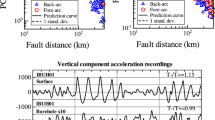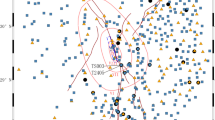Abstract
The effect of seismic super-shear rupture on the directivity of ground motions using simulated accelerations of a vertical strike-slip fault model is the topic of this study. The discrete wave number/finite element method was adopted to calculate the ground motion in the horizontal layered half space. An analysis of peak ground acceleration (PGA) indicates that similar to the sub-shear situation, directivity also exists in the super-shear situation. However, there are some differences as follows: (1) The PGA of the fault-normal component decreases with super-shear velocity, and the areas that were significantly affected by directivity in the PGA field changed from a cone-shaped region in the forward direction in a sub-shear situation to a limited near-fault region in a super-shear situation. (2) The PGA of the fault-parallel and vertical component is not as sensitive as the fault-normal component to the increasing super-shear velocity. (3) The PGA of the fault-normal component is not always greater than the fault-parallel component when the rupture velocity exceeds the shear wave velocity.
Similar content being viewed by others
References
Andrews DJ (1976), “Rupture Velocity of Plane Strain Shear Cracks,” Journal of Geophysical Research, 81(32): 5679–5687.
Andrews DJ and Harris RA (2005), “The Wrinkle-like Slip Pulse is not Important in Earthquake Dynamics,” Geophysical Research Letters, 32: L23303.
Andrews DJ and Harris RA (2006), “Reply to Comment by Y. Ben-Zion. The Wrinkle-like Slip Pulse is not Important in Earthquake Dynamics,” Geophysical Research Letters, 33: L06311.
Archuleta RJ (1984), “A Faulting Model for the 1979 Imperial Valley Earthquake,” Journal of Geophysical Research, 89(B6): 4559–4585.
Bakun WH, Stewart RM and Bufe CG (1978), “Directivity in the High-frequency Radiation of Small Earthquakes,” Bulletin of the Seismological Society of America, 68: 1253–1263.
Benioff H (1955), “Mechanism and Strain Characteristics of the White Wolf Fault as Indicated by the Aftershock Sequence; Earthquakes in Kern County, California during 1952,” California Division of Mines Bulletin, 171: 199–202.
Bernard P and Madariaga R (1984a), “A New Asymptotic Method for the Modeling of Near Field Accelerograms,” Bulletin of the Seismological Society of America, 74(2): 539–557.
Bernard P and Madariaga R (1984b), “High Frequency Seismic Radiation from a Buried Circular Fault,” Geophysical Journal of the Royal Astronomical Society, 78:1–18.
Boatwright J and Boore DM (1982), “Analysis of the Ground Accelerations Radiated by the 1980 Livermore Valley Earthquakes for Directivity and Dynamic Source Characteristics,” Bulletin of the Seismological Society of America, 72(6A): 1843–1865.
Bouchon M, Bouin MP, Karabulut H, Toksöz MN, Dietrich M and Rosakis AJ (2001), “How Fast is Rupture during an Earthquake? New insights from the 1999 Turkey Earthquakes,” Geophysical Research Letters, 28(14): 2723–2726.
Bouchon M, Toksöz N, Karabulut H, Bouin, MP, Dietrich M, Aktar M and Edie M (2000), “Seismic Imaging of the 1999 Izmit (Turkey) Rupture Inferred from the Near-fault Recordings,” Geophysical Research Letters, 27(18): 3013–3016.
Bouchon M and Vallée M (2003), “Observation of Long Supershear Rupture during the Magnitude 8.1 Kunlunshan Earthquake,” Science, 301(5634): 824–826.
Burridge R (1973), “Admissible Speeds for Plane-strain Shear Cracks with Friction but Lacking Cohesion,” Geophysical Journal of the Royal Astronomical Society, 35: 439–455.
Das S (2007), “The Need to Study Speed,” Science, 2007(317): 905–906.
Das S and Aki K (1977), “A Numerical Study of Two-dimensional Spontaneous Rupture Propagation,” Geophysical Journal of the Royal Astronomical Society, 50: 643–668.
Dunham EM and Archuleta RJ (2004), “Evidence for a Supershear Transient during the 2002 Denali Fault Earthquake,” Bulletin of the Seismological Society of America, 94(6B): S256–S268.
Dunham EM, Favreau P and Carlson JM (2003), “A Supershear Transition Mechanism for Cracks,” Science, 299(5612): 1557–1559.
Eberhart-Phillips D, Haeussle PJ, Freymueller JT, Frankel AD, Rubin CM, Craw P, Ratchkovski NA, Anderson G, Carver GA, Crone AJ, Dawson TE, Fletcher H, Hansen R, Harp EL, Harris RA, Hill DP, Hreinsdóttir S, Jibson RW, Jones LM, Kayen R, Keefer DK, Larsen CF, Moran SC, Personius SF, Plafker G, Sherrod B, Sieh K, Sitar N and Wallace WK (2003), “The 2002 Denali Fault Earthquake, Alaska: A Large Magnitude, Slippartitioned Event,” Science, 300(5622): 1113–1118.
Hanks TC and Kanamori H (1979), “A Moment Magnitude Scale,” Journal of Geophysical Research, 84(B5): 2348–2350.
Haskell NA (1964), “Total Energy and Energy Spectral Density of Elastic Wave Radiation from Propagating Faults,” Bulletin of the Seismological Society of America, 54(6A): 1811–1841.
Haskell NA (1966), “Total Energy and Energy Spectral Density of Elastic Wave Radiation from Propagating Faults. Part II. A Statistical Source Model,” Bulletin of the Seismological Society of America, 56(1): 125–140.
Hirasawa T and Stauder W (1965), “On the Seismic Body Waves from a Finite Moving Source,” Bulletin of the Seismological Society of America, 55(2): 237–262.
Hu Jinjun (2009), “Rupture Directivity of Near-fault Ground Motion and Super-shear Rupture,” PhD Dissertation, Institute on Engineering Mechanics, China Earthquake Administration, Harbin, China. (in Chinese)
Hu Jinjun and Xie Lili (2011), “Review of the State-ofthe Art Researches on Earthquake Super-shear Rupture,” Advances in Earth Science, 26(1): 39–47. (in Chinese).
Kasahara K (1984), Earthquake Mechanics, Earthquake Publishing House, Beijing, China, pp. 248.
Oglesby DD, Dreger DS, Harris RA, Ratchkovski N and Hansen R (2004), “Inverse Kinematic and Forward Dynamic Models of the 2002 Denali Fault Earthquake, Alaska,” Bulletin of the Seismological Society of America, 94(6B), S214–S233.
Olson AH and Apsel R (1982), “Finite Faults and Inversion Theory with Applications to the 1979 Imperial Valley Earthquake,” Bulletin of the Seismological Society of America, 72(6A): 1969–2001.
Olson AH, Orcutt JA and Frazier GA (1984), “The Discrete Wavenumber/finite Element Method for Synthetic Seismograms,” Geophysical Journal of the Royal Astronomical Society, 77: 421–460.
Robinson DP, Brough C and Das S (2006), “The Mw 7.8, 2001 Kunlunshan earthquake: Extreme Rupture Speed Variability and Effect of Fault Geometry,” Journal of Geophysical Research, 111: B08303.
Schmedes J and Archuleta RJ (2008), “Near-source Ground Motion Along Strike Slip Faults: Insights into Magnitude Saturation of PGV and PGA,” Bulletin of the Seismological Society of America, 98(5): 2278–2290.
Somerville PG, Irikura K, Graves RW, Sawada S, Wald D, Abrahamson NA, Iwasaki Y, Kagawa T, Smith N and Kowada A (1999), “Characterizing Crustal Earthquake Slip Models for the Prediction of Strong Ground Motion,” Seismological Research Letters, 70(1): 59–80.
Somerville PG, Smith NF, Graves RW and Abrahamson NA (1997), “Modification of Empirical Strong Ground Motion Attenuation Relations to Include the Amplitude and Duration Effects of Rupture Directivity,” Seismological Research Letters, 68(1): 199–222.
Spudich P and Archuleta R (1987), “Techniques for Earthquake Ground Motion Calculation with Applications to Source Parameterization of Finite Faults,” Bolt, B.A. ed., Seismic Strong Motion Synthetics, Orlando, Florida, Academic Press, 265 pp.
Spudich P and Cranswick E (1984), “Direct Observation of Rupture Propagation during the 1979 Imperial Valley Earthquake Using a Short Baseline Accelerometer Array,” Bulletin of the Seismological Society of America, 74(6): 2083–2114.
Spudich P and Frazer N (1984), “Use of Ray Theory to Calculate High-frequency Radiation from Earthquake Sources Having Spatially Variable Rupture Velocity and Stress Drop,” Bulletin of the Seismological Society of America, 74(1): 2061–2082.
Spudich P and Xu LS (2003), “Software for Calculating Earthquake Ground Motions from Finite Faults in Vertically Varying Media, in International Handbook of Earthquake and Engineering Seismology,” W. H. K. Lee, H. Kanamori, P. C. Jennings, and C. Kisslinger (editors), Academic Press, New York, Part B, ch. 85-14, pp. 1633–1634.
Wells DL and Coppersmith KJ (1994), “New Empirical Relationships among Magnitude, Rupture Length, Rupture Width, Rupture Area, and Surface Displacement,” Bulletin of the Seismological Society of America, 84(4): 974–1002.
Xia KW, Rosakis AJ and Kanamori H (2004), “Laboratory Earthquakes: The Sub-Rayleigh-tosupershear Rupture Transition,” Science, 303(5665): 1859–1861.
Xia KW, Rosakis AJ and Kanamori H (2005a), “Supershear and Sub-Rayleigh-intersonic Transition Observed in Laboratory Earthquake Experiments,” Experimental Techniques, 29(3): 63–66.
Xia KW, Rosakis AJ, Kanamori H and Rice JR (2005b), “Laboratory Earthquakes along Inhomogeneous Faults: Directionality and Supershear,” Science, 308(5722): 681–684.
Author information
Authors and Affiliations
Corresponding author
Additional information
Supported by: Basic Science Research Foundation of IEM, CEA under Grant No. 2011B02; 973 Program under Grant No. 2011CB013601; National Natural Science Foundation of China under Grant Nos. 51238012, 9121530113; International Science & Technology Cooperation Program of China under Grant No. 2012DFA70810
Rights and permissions
About this article
Cite this article
Hu, J., Xie, L. Effect of seismic super-shear rupture on the directivity of ground motion acceleration. Earthq. Eng. Eng. Vib. 12, 519–527 (2013). https://doi.org/10.1007/s11803-013-0193-x
Received:
Accepted:
Published:
Issue Date:
DOI: https://doi.org/10.1007/s11803-013-0193-x




